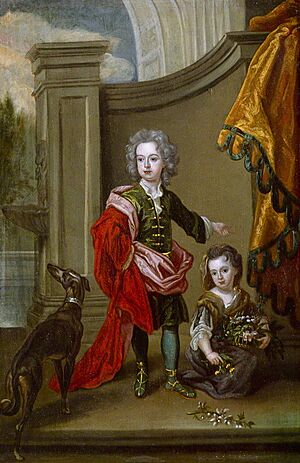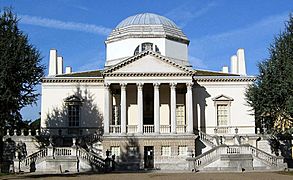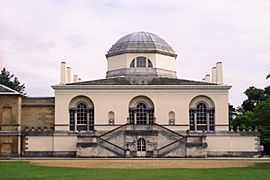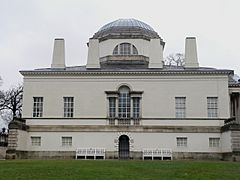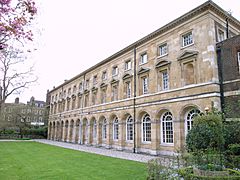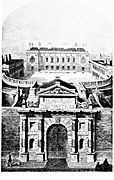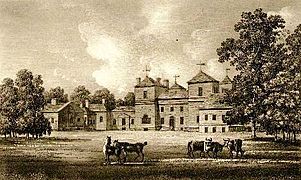Richard Boyle, 3rd Earl of Burlington facts for kids
Quick facts for kids
The Earl of Burlington and Cork
|
|
|---|---|
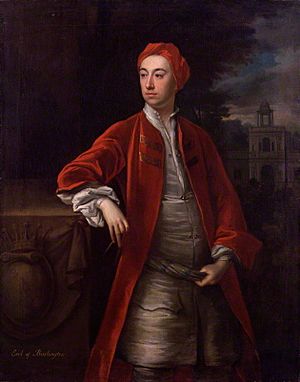
Portrait by Jonathan Richardson, c. 1718
|
|
| Lord High Treasurer of Ireland | |
| In office 25 August 1715 – 3 December 1753 |
|
| Preceded by | The Lord Carleton |
| Succeeded by | Marquess of Hartington |
| Personal details | |
| Born | 25 April 1694 Yorkshire, England |
| Died | 4 December 1753 (aged 59) Chiswick House, London |
| Spouse | Lady Dorothy Savile |
| Children |
|
| Parents |
|
Richard Boyle, 3rd Earl of Burlington and 4th Earl of Cork (born April 25, 1694 – died December 4, 1753) was a British architect and a noble. He was often called the "Apollo of the Arts" and the "Architect Earl." He was the son of the 2nd Earl of Burlington.
Even though he held important political positions, Richard Boyle was not very interested in politics. His main passions were architecture and designing landscapes. He is famous for bringing a style of building called Palladian architecture to Britain and Ireland. Some of his most important projects include Burlington House, Westminster School, and Chiswick House.
Contents
Life of Richard Boyle
Lord Burlington was born in Yorkshire, England. He came from a very rich and important family. He was the only son of Charles Boyle, the 2nd Earl of Burlington.
When his father died in 1704, Richard was only nine years old. He inherited his father's titles and large estates. His mother managed his lands and political interests until he turned 21 in 1715.
Richard loved music from a young age. The famous composer Georg Frideric Handel even dedicated two of his operas to Burlington. These operas were Teseo and Amadigi di Gaula. Handel stayed at Burlington's home, Burlington House, for a time.
Developing His Style
Between 1714 and 1719, Lord Burlington went on three "Grand Tours" of Europe. A Grand Tour was a long trip that young, wealthy people took to learn about art and culture. He also visited Paris in 1726. These trips helped him develop his taste in architecture.
During his 1719 tour, he visited the Veneto region in Italy. He carried a copy of a famous book by Andrea Palladio called I quattro libri dell'architettura. This book was about classical Roman and Greek architecture. It was on this trip that he became very passionate about Palladian architecture.
In 1719, he also helped start the Royal Academy of Music. This group put on baroque opera shows.
Early Architectural Projects
Lord Burlington's first big project was his own home in London, Burlington House. When he returned from his travels in 1719, he stopped working with his old architect, James Gibbs. Instead, he hired Colen Campbell and William Kent.
The front of Burlington House was the first major example of the new Neo-Palladian style in Britain. This style was based on the ideas of Andrea Palladio.
In the 1720s, Burlington worked with younger architects like Henry Flitcroft and Daniel Garrett. They helped him with his projects.
Palladian Influence
Lord Burlington did not often visit ancient Roman ruins himself. He relied on the drawings and interpretations of Palladio and another architect named Vincenzo Scamozzi. They helped him understand the classic Roman style.
Burlington collected many drawings, including some by Palladio and Inigo Jones. Inigo Jones was an important English architect who also admired Palladio. Burlington used these drawings to inspire his own designs.
By the early 1730s, the Palladian style became very popular in Britain. It was used for many country houses and public buildings. Lord Burlington was seen as the leader of this new style.
In 1739, Lord Burlington helped start the Foundling Hospital. This was a charity that cared for children. He was a governor of the charity, but another architect designed the building.
Many of Lord Burlington's buildings have been changed or lost over time. However, his architectural drawings are kept at Chatsworth House. These drawings help us understand his designs today. In 1751, he sent some of his drawings to Francesco Algarotti in Germany.
-
This is a palace front drawn by Andrea Palladio. Inigo Jones bought it in Italy. Burlington later bought it from Jones's student, John Webb. He used it for General Wade's house in London. Notice the special Palladian window.
-
This picture shows Colen Campbell's Burlington House in 1855. A third floor was added later.
Major Architectural Projects
Lord Burlington was a very active architect and designer. Here are some of his most important projects:
Burlington House, London
- Located in Piccadilly, London.
- Lord Burlington likely designed the old colonnade (a row of columns) and the grand entrance gate.
- He also redesigned the main rooms inside the house in the Palladian style.
- Sadly, many of his smaller designs for other London homes have not survived.
Tottenham House, Wiltshire
- Built starting in 1721 for his brother-in-law.
- Lord Burlington's assistant, Henry Flitcroft, helped build it.
- The original house had special "Palladian window" designs, similar to Burlington House.
- Burlington also designed beautiful buildings in the park around the house.
Westminster School Dormitory
- Built between 1722 and 1730.
- This was Lord Burlington's first public building project.
- His design was chosen over one by the famous architect Christopher Wren. This showed how popular the Palladian style was becoming.
Old Burlington Street Houses, London
- He designed several houses on this street.
- One house, built for General Wade in 1723, used a real Palladio design from Burlington's collection of drawings.
- The Belvedere Tower was built here between 1725 and 1727.
- This tower was designed to be a beautiful "eye-catcher" in the garden.
Chiswick House Villa, Middlesex
- The "Casina" (a small house) in the gardens was his first design in 1717.
- The main villa, built between 1727 and 1729, is considered one of the best examples of Neo-Palladian architecture.
- Burlington wanted to create a Roman villa surrounded by a symbolic Roman garden.
- He designed the villa to hold his large art collection, which included "some of the best pictures in Europe."
Sevenoaks School, School House
- Built in 1730.
- This building shows classic Palladian design.
The York Assembly Rooms
- Built between 1731 and 1732.
- Lord Burlington tried to rebuild an "Egyptian Hall" described by an ancient Roman architect named Vitruvius.
- The result was one of the grandest public spaces in the Palladian style.
Other Projects
- Castle Hill, Devonshire.
- Northwick Park, Gloucestershire.
- Kirby Hall, Yorkshire (an elevation drawing).
Family Life

Lord Burlington married Lady Dorothy Savile on March 21, 1720. She was the daughter of William Savile, 2nd Marquess of Halifax.
They had three daughters:
- Lady Dorothy Boyle (1724–1742). She married George FitzRoy, Earl of Euston. They did not have any known children.
- Lady Julianna Boyle (1727–1730).
- Lady Charlotte Elizabeth Boyle (1731–1754). She married William Cavendish, Marquess of Hartington. They had several children, including William Cavendish, 5th Duke of Devonshire.
Lord Burlington died at Chiswick House when he was 59 years old. When he died, his title of Earl of Burlington ended. However, it was later brought back in 1831 for his grandson, George Cavendish. Today, the title is used by the Cavendish family as a courtesy title for the Dukes of Devonshire.
Gallery of Architectural Works
See also
 In Spanish: Richard Boyle para niños
In Spanish: Richard Boyle para niños


